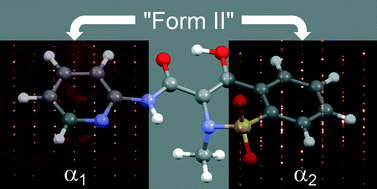Crystallization and disorder of the polytypic α1 and α2 polymorphs of piroxicam†
Abstract
Polymorphism of the active pharmaceutical ingredient piroxicam, C15H13N3O4S, is investigated with an aim to clarify the identity and crystallization conditions of the α1 and α2 polymorphs. The structures are polytypic, containing identical 2-dimensional layers, with different symmetry relationships between the layers. The α1 structure is orthorhombic and non-centrosymmetric (space group type Pca21), while the α2 structure is monoclinic and centrosymmetric (space group type P21/c). α2 can be crystallized by evaporation from ethanol at 25 °C, while α1 is obtained by crystallization from the same solvent at 4 °C. The polytypic relationship provides a suitable condition for order–disorder phenomena to be observed in single crystals. Intermolecular interaction energies calculated using the PIXEL method suggest that the centrosymmetric interlayer regions in α2 involving the pyridyl groups are more stabilising than the corresponding non-centrosymmetric interlayer regions in α1. This is consistent with observations of inversion twinning in non-centrosymmetric α1 crystals. The interlayer regions involving the benzothiazine groups have very similar interaction energies in the two structures.

- This article is part of the themed collection: Polymorphism

 Please wait while we load your content...
Please wait while we load your content...